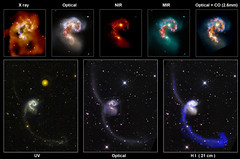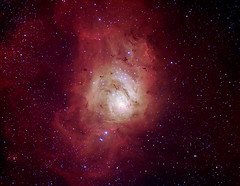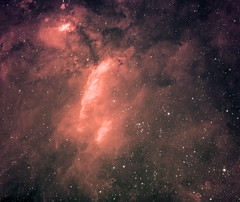A very nice example of a nebula surrounding a Wolf-Rayet star is the so-called Crescent Nebula (NGC 6888, Caldwell 27, Sharpless 105). Located in the northern constellation of Gygnus, The Swan, it lies at around 5000 light years from us. The Crescent Nebula has been formed by the strong stellar winds of the Wolf-Rayet star WR 136 (HD 192163), which is located in the center of the nebula. This is an image of the Crescent Nebula I took in 2004 using the 2.5m Isaac Newton Telescope (INT) at the Roque de los Muchachos Observatory (La Palma, Spain) while I was still preparing my PhD Thesis at the Instituto de Astrofísica de Canarias (IAC, Tenerife, Spain) about the properties of dwarf galaxies hosting Wolf-Rayet stars. Actually, the image was taken during the twilight, when sky is still dark enough the get details in the narrow-band filters.

Image of the Crescent Nebula (NGC 6888) obtained by the author combining data using the broad-band optical B filter (blue) and the narrow-band optical filters [O III] (green) and Hα (red) obtained using the Wide Field Camera (WFC) attached at the 2.5m Isaac Newton Telescope (INT) at the Roque de los Muchachos Observatory (La Palma, Spain). The size of the image is around 22 x 22 arcminutes, just slightly smaller than the field of view of the full moon in the sky (30 arcminutes in diameter). Credit: Ángel R. López-Sánchez
The image clearly shows ionized gas (nebular emission) with very different conditions: while red-color (Hα emission) is tracing the normal, emitting ionized gas, the green colour ([O III] emission) indicates regions with high excitation of the gas, meaning higher temperatures probably because of shocks. In just some few hundreds of years the star will explode as type-II supernova and destroy all the nebula, although it will create a new object: a supernova remnant.







